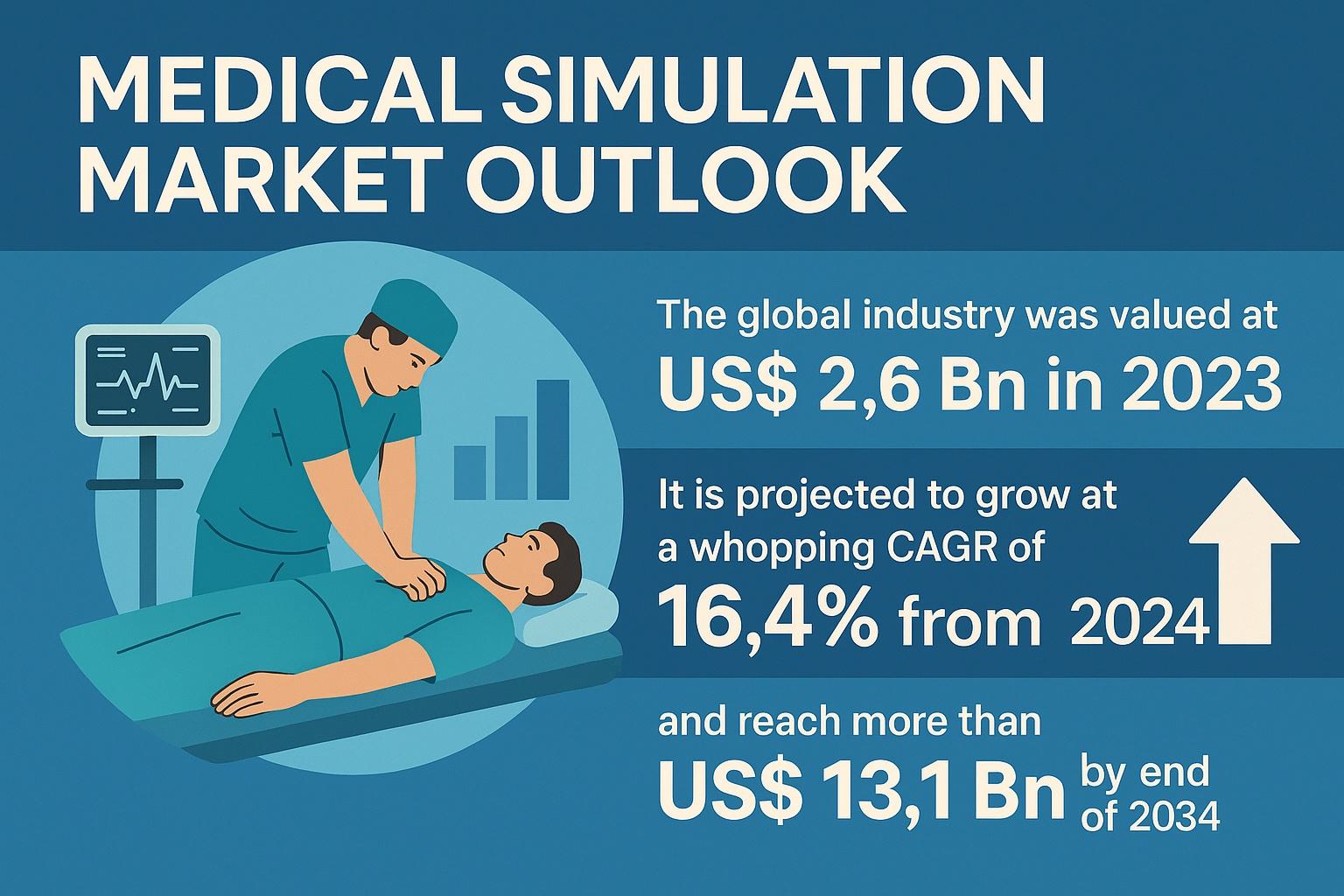The Medical Simulation Market is entering a period of unprecedented expansion, powered by advanced digital technologies, growing emphasis on patient safety, and rising global adoption of minimally invasive surgical procedures. Valued at US$ 2.6 Bn in 2023, the market is forecast to surge at an impressive CAGR of 16.4%, reaching over US$ 13.1 Bn by 2034. The transition toward simulation-based training is reshaping how healthcare professionals learn, practice, and refine clinical skills without exposing real patients to risk.
Transformative Role of VR, AI, and High-Fidelity Haptic Systems
Modern medical simulation has evolved far beyond traditional mannequins. Today, technologies such as Virtual Reality (VR), Artificial Intelligence (AI), Machine Learning (ML), and advanced haptics are reshaping the landscape of healthcare education.
VR Platforms Redefining Realism in Training
Companies like Osso VR and ImmersiveTouch have revolutionized simulation-based learning by enabling:
-
Conversion of 2D scans into dynamic 3D anatomical models
-
Highly immersive, repeatable training scenarios
-
True-to-life hand interactions without physical controllers
-
Multi-user collaborative simulations for team-based procedures
Surgeons can now rehearse complex spinal, cardiac, orthopedic, and laparoscopic procedures in controlled, hands-on virtual environments that mirror real-world pressures and clinical challenges.
AI-Driven Predictive Insights and Personalized Skill Development
AI integration is emerging as a critical trend in the Medical Simulation Market. Platforms like FundamentaIVR embed predictive analytics that:
-
Assess surgeon performance
-
Provide real-time feedback
-
Customize training pathways
-
Identify skill gaps with high accuracy
These capabilities are significantly improving competency-based medical education.
Haptic Feedback Enhancing Surgical Skills
Advanced haptic systems replicate the tactile feel of tissues, instruments, and resistance levels, enabling realistic practice in:
-
Surgical suturing
-
Endoscopy and laparoscopy
-
Interventional cardiology
-
Obstetrics and gynecology
This level of precision is transforming training outcomes across specialties.
Minimally Invasive Surgery: A Key Driver
Demand for Minimally Invasive Surgery (MIS) continues to rise globally due to advantages such as:
-
Faster recovery
-
Reduced risk of complications
-
Shorter hospital stay
-
Lower postoperative pain
As MIS techniques require exceptional precision and skill, simulation-based training is essential. Studies published in Clinical Spine Surgery show that patients overwhelmingly prefer MIS due to better long-term outcomes and reduced discomfort.
Simulation platforms allow surgeons to master:
-
Hand-eye coordination
-
Depth perception
-
Instrument handling
-
Complex procedural workflows
Hence, MIS remains a primary force fueling market expansion.
Expanding Adoption Across Hospitals, Academic Institutes, and Military Organizations
Hospitals are expected to dominate the end-user segment through 2034. Leading institutions worldwide are adopting simulation facilities to train healthcare workers before they interact with patients.
Notable Examples
-
SimVET Hospital, Orlando – A US$ 43M Veterans Affairs simulation center featuring high-fidelity suites for emergency, surgical, and diagnostic training.
-
Sheikh Shakhbout Medical City, UAE – A premier simulation hub offering specialized units for pediatric, gynecology, trauma, and critical care training.
Such investments set new benchmarks in healthcare education, push digital adoption, and accelerate market growth.
Regional Outlook: North America Leads the Global Market
North America remains the largest regional market due to:
-
Strong government funding
-
Advanced healthcare systems
-
Higher adoption of VR/AR and AI-based systems
-
Extensive network of simulation centers
-
Integration of simulation into medical curricula
The U.S. and Canada are pioneers in simulation-based accreditation and training, resulting in consistently rising demand for simulation tools and platforms.
Competitive Landscape: Innovation-Driven Growth
Key players shaping the global Medical Simulation Market include:
-
Surgical Science Sweden AB
-
Laerdal
-
Limbs & Things
-
Simulaids Inc.
-
Simulab Corporation
-
Kyoto Kagaku Co., Ltd.
-
Mentice AB
-
Gaumard Scientific
-
Elevate Healthcare
These companies are striving to deliver high-fidelity solutions through:
-
Mixed reality surgical simulators
-
AI-based assessment tools
-
Cloud-enabled training modules
-
Procedure rehearsal technologies
-
3D-printed anatomical models
Recent Key Developments
-
2024 – GE Healthcare launched Revolution RT, improving imaging accuracy in radiation therapy simulation.
-
2023 – Limbs & Things & TruCorp entered a multi-million partnership covering major markets.
-
2022 – Inovus Medical introduced HystAR, a next-generation AR-enabled hysteroscopy simulator.



